0
COMMENTS
Antique Vintage Deco Retro Sterling Silver Jewelart HUGE Charm 8.5 Bracelet
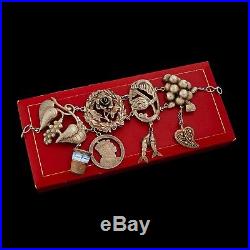
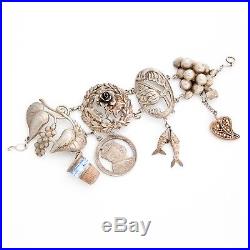
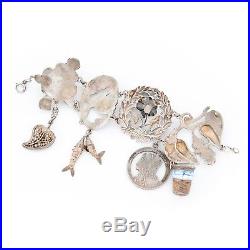
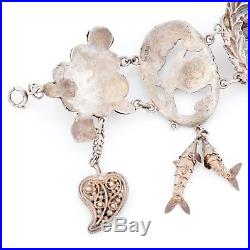
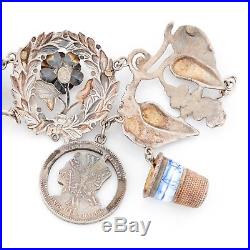
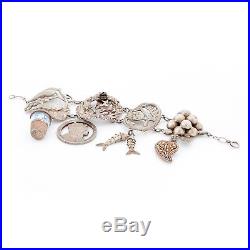
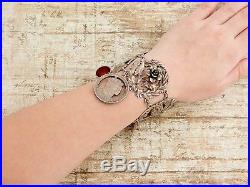
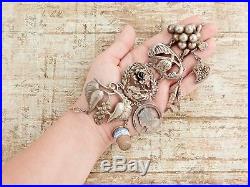

Age Circa : Retro C. Markings : Sterling by Jewelart on the back of the flower and wreath panel link; 980 on the back of the grape panel link; All of the unmarked pieces are tested and guaranteed. Country of Origin : United States (Jewelart), China (koi fish charms), Holland (Dutch thimble), Mexico (grape cluster), Italy (chili pepper), Germany (Prussian coin). Brand : The flower and wreath panel link is by Jewel Art. The rest of the pieces are unknown. Gram Weight : 77.2 Grams. 980 Silver (Grape Cluster), Coin Silver (Prussian coin). Main Stone Measurements/Color. Accent Stone Measurements/Color. Item Measurements : The bracelet measures 8.5″ in length by 2.5″ in width, not including the dangling charms. The thimble measures 0.89″ in length by 0.71″ in width. The coin measures 1.2 in diameter. The longer koi fish measures 1.2″ in length by 0.26″ in width. The chili pepper measures 1.0″ in length by 0.75″ in width. Bracelet Type : Charm Bracelet. Closure/Clasp Type : Spring Clasp. Link Type : Panel Links. Notable Features : This stunning sterling silver charm bracelet was handmade during the Retro period of the Art Deco era using panel links and charms, which were collected during a Grand Tour while traveling the world. The bracelet was assembled during different times as pieces were collected. The first panel link features a lovely grape cluster with large grape leaves, which was made during the Art Nouveau era using the repousse technique. From this link dangles a charming Dutch enamel thimble with a blue and white scene of sailboats on the water, a windmill, trees, and animals grazing in a field. The second panel was made during Art Deco Retro period by Jewel Art and features a gorgeous three-dimensional rose centered inside a laurel wreath pattern. From this link dangles a Victorian Prussian coin, dated 1861, which commemorates the coronation of King Wilhelm I and Queen Augusta. The coin has been cut out to highlight their profiles. The third panel features a whimsical Art Nouveau floral motif, which was formed using the repousse technique. From this panel dangle two Chinese export koi fish, which have articulated bodies with delicately chased scales. The final panel features a three-dimensional grape cluster which was handmade in Mexico in the Taxco silversmithing tradition. From this panel dangles an ornate Etruscan style chili pepper, which was made in Italy, and is adorned with tiny granulated beads and rope twist accents. The bracelet is finished with a large sturdy spring clasp and has extra rings to attach more charms. This large bracelet is heavy in metal value and makes quite the impact when worn. Don’t miss your chance to make a statement and add to the story of this beautiful bracelet! Damage : Age appropriate wear. This listing is for the item only. The Art Deco era is famous for being the “Gatsby” or “Roaring Twenties” era. A lot of gorgeous and timeless designs in jewelry came out of this period. Jewelry from this period was most often crafted between 1920 and 1940. Art Deco jewelry sometimes featured white gold or platinum, geometric designs, European cut diamonds, filigree, and calibre cut stones that are specifically cut to fit the design of the piece. During the Art Deco period jewelers often made jewelry upon custom order, this would often take weeks to months to completely craft by hand. Retro jewelry refers to pieces created in the 1940s and 1950s. This was a period during which jewelry designers were largely influenced by the changes stemming from World War II. These designs reflect an infusion of futuristic vision with elements inspired by preceding periods, encompassing a variety of gemstones, shapes, and materials. Materials used commonly in Retro jewelry are gold, gold alloys, and silver as the wartime put a restriction on the use of platinum. Designs can be masculine, geometric and modern, or softer, more feminine and floral. The Grand Tour was the standard European vacation of the Georgian and Victorian eras. The opportunity it gave for studying culture, architecture and art made it a tradition, especially for the upper classes. And what better souvenir of this long trip than pieces of native souvenir jewelry such as Italian cameos, mosaic, and pietra dura pieces. Pieces often had historical inspirations from the remnants of Pompeii to the pyramids of Egypt. Cultural learning was a focal point of the grand tour and the process of remembrance spilled over into jewelry souvenirs. The Victorian period, 1837 – 1901, is famous for its very rare and elegant, hard to find designs! Queen Victoria was the ruling monarch during this period, hence the name Victorian. The Victorian period has three very distinct periods including the Romantic, Grand, and Late Victorian. Jewelry was often worn in abundance and expressed the wearers wealth and social status. This period featured floral motifs, birds, bows, intricately engraved gold, enamel, and intricate seed pearl designs. This was very true due to the gorgeous designs that came out of this period. This era focused on women and the beauty of nature and the pieces were often large. Enamel was a common material used in Art Nouveau jewelry as the period was more about the importance of the design over the materials used to create it. The Art Nouveau period happened before the start of the first world war, when mass manufacturing took over production of many products, including some jewelry. Chinese export jewelry became popular during the late Victorian period and persisted until the 1960s. During this period, Chinese craftsmen were considered by far the best in the world. The rich and wealthy would custom-order a piece through their local jeweler, who would send the design off to China to be made and sent back to Europe. This lengthy process was very expensive, making Chinese export pieces highly desirable, then and now. Articulated pieces of jewelry are usually composed of two or more pieces connected by a flexible joint, hinge, or pivot to allow for realistic movement. This technique is used to lend a lifelike quality to animal figures, or to allow jewelry to drape elegantly, like a snake chain. Etruscan revival jewelry swept into popularity in the early 1800s with the Victorian era discovery of Etruscan tombs just outside of Rome in Italy. These archaeological digs unearthed beautiful golden jewelry that had been meticulously ornamented with tiny gold beads, featuring flowing geometric shapes, celestial motifs, and a plethora of sacred and Greco-Roman mythological figures. The techniques of repoussé, filigree, and granulation are all attributed to the Etruscans. Jewelers all over the world avidly began to attempt to replicate these ancient techniques, changing the way fine jewelry was made for many years. Taxco, Mexico is famous for producing the finest sterling silver jewelry in the world. Taxco has a rich history of silver-making, with the Aztecs being the first to mine and craft sterling silver for adornment and ceremony. In the 1920s, an American artist named William Spratling moved to Taxco. Being inspired by pre-Columbian and Aztec art, Spratling built a successful jewelry business. Many local aspiring artisans started apprenticing under him, and he eventually developed an apprenticeship program, with many famous silversmiths having learned there. The Taxco tradition of silversmithing is still carried on by the local artisan community today. 980 silver is sterling silver that is 98% purity of fine silver and is considered rare. It is purer than 925 sterling silver. This type of silver was not used very often, but when it was, it was typically found in Mexican Taxco designs. Repoussé began as an ancient metal working technique dating as far back as the 3rd century BC, involving malleable metal that was hammered onto the reverse side to create an image on the front. Examples are found all over the world; Greece, Egypt, and even the Hopewell periods in the American southeast. Reverse side hammering was also used to add detail to the front, creating intricate patterns using grooves, indentations, and channeling. The piece was then carefully polished to create a hollow, eye-catching treasure. Started in Providence Rhode Island, circa 1946, following WWII, and was famous for creating beautiful, handmade sterling silver and fine jewelry. Chasing is a metalworking technique that uses a nail-like tool and hammer to hand etch patterns onto a metal surface. This process creates a design that is sunk into the front of the surface using indentations, grooves, and channels. Chasing is thousands of years old and was very difficult and time-consuming technique that is still used by metalsmiths today. Enameling originally dates all the way back to the ancient Persians of Meenakari. The technique involves bonding powdered glass to a base, usually gold, by firing (heating and melting the glass onto the metal). The glass hardens to form a layer of pigment over the metal. Enamel is made of colored powdered glass or may include clear powdered glass that is mixed with colorful metallic pigments. It was used by the ancient Egyptians, Greeks, and Celts; and later the Chinese and Georgians. It resurged in popularity in the 20th century. It is primarily used on decorative art or jewelry, usually small in size. Besides jewelry, enamel can also be applied to glass, ceramic, stone, and various other materials. We do not undervalue packages for international customers as it is illegal. The item “Antique Vintage Deco Retro Sterling Silver Jewelart HUGE Charm 8.5 Bracelet” is in sale since Sunday, June 10, 2018. This item is in the category “Jewelry & Watches\Vintage & Antique Jewelry\Fine\Art Nouveau/Art Deco 1895-1935\Bracelets”. The seller is “abeautifultimeco” and is located in Fort Collins, Colorado. This item can be shipped worldwide.
- 2nd Metal: Silver
- 2nd Metal Purity: .980
- 3rd Metal: Coin Silver
- Country/Region of Manufacture: Unknown
- Style: Chain
- Material: Enamel
- Metal Purity: .925
- Metal: Sterling Silver
